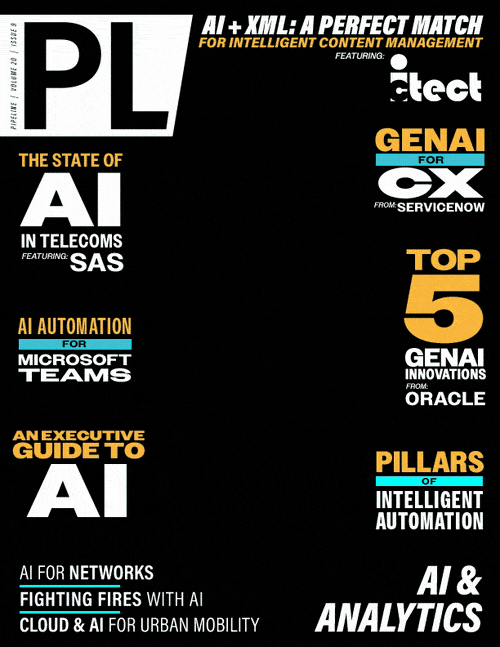Transforming Telecommunications:
The Role of AI in Modern Networks
Automation is another significant advantage AI brings to network operations. AI can optimize network capacity and manage traffic dynamically, adapting to real-time demand without human
intervention. This reduces the workload on network operators and improves efficiency and response times. Imagine a scenario where a sudden surge in data traffic occurs: AI can instantly allocate
resources to manage the load, maintaining seamless, unbroken connectivity for users. This level of automation ensures that network services remain reliable and can meet the ever-increasing
expectations of both consumers and businesses.
AI Testing AI
Testing and assuring the quality of telecoms networks have always been challenging, but AI is now transforming these critical processes. Traditional testing methods that involve manual oversight and periodic assessment often fall short when it comes to handling the sheer complexity and scale of modern networks. AI addresses this by enabling continuous and comprehensive testing, which can simulate a wide range of scenarios to evaluate network performance. For instance, AI-driven testing platforms can mimic different network loads, interference patterns, and even potential cyberattacks, providing a thorough overview of network resilience. It can also create new unforeseen scenarios and test against them, increasing network robustness. This ensures that networks are not only ready for current demands but also future-proofed against upcoming challenges.
But who watches the watcher? With AI systems making many real-time decisions within networks, it’s essential to ensure these systems operate correctly and without bias. AI-based testing tools can evaluate other AI systems, ensuring they perform as expected under various conditions. For example, an AI tool can monitor and test the algorithms responsible for network traffic management, identifying any deviations or inefficiencies that need correction. This AI testing AI approach also helps build trust in AI technologies by providing a rigorous framework for their validation and assurance.
Enhanced Field Operations
Everything the end user experiences is the direct result of how a network has been designed and deployed. AI is revolutionizing field operations in telecoms by assisting technicians with network deployment, maintenance, testing, and optimization. Traditionally, field technicians required extensive training and experience to handle complex installations and repairs. Now, AI-powered tools are providing real-time guidance and support. For example, augmented reality (AR) applications, powered by AI, can overlay instructions and diagnostic information directly onto a technician’s field of view, making it easier to install or repair network components. This not only speeds up the process but also reduces the likelihood of human error and the need for repeat visits, ensuring higher reliability and efficiency in field operations.
Self-Healing Networks and the Road Ahead
As the telecommunications industry evolves, AI will continue to play a pivotal role in shaping the future of network operations. One significant trend is the development of “self-healing” networks. These networks use sophisticated algorithms to continuously monitor performance and detect anomalies in real-time. When an issue such as unexpected congestion or hardware failure arises, the AI system can autonomously diagnose the problem and implement corrective measures without human intervention. This capability is especially crucial as networks handle increasing data from IoT devices, autonomous vehicles, and other advanced applications that are too numerous to be optimized manually. By enabling networks to self-correct and adapt dynamically, AI-driven self-healing networks are setting new standards for operational reliability in telecoms.
However, integrating AI into telecoms does present several challenges. One major concern is ensuring the ethical and transparent use of AI. As AI systems make more real-time decisions, there's a need for transparency and accountability. For example, if an AI system wrongly reroutes traffic, leading to service outages, understanding why that decision was made is critical to ensuring it doesn’t happen again. We also need to be mindful of biases that could impact the performance of AI. Left unchecked, biases self-reinforce and lead to small mistakes becoming potentially catastrophic in time. The industry must also establish regulatory frameworks to govern AI use in telecoms, ensuring that these technologies enhance network reliability without compromising ethical standards. This is already underway. The EU AI Act, for instance, has introduced new frameworks to categorize AI systems based on their potential impact on safety, infrastructure and privacy. Several AI applications within the telecoms sector have already been flagged as potentially high-risk, with regulation set to follow.
Our reliance on connectivity has grown dramatically in the last few decades, and that reliance is set to deepen. By leveraging AI, we can ensure that our connectivity infrastructure is safeguarded, resilient, and immutable as we continue to develop game-changing use cases for the betterment of society. If connectivity is the central pillar, then AI is the surrounding scaffolding, strengthening it and protecting it against headwinds both known and unknown.



















